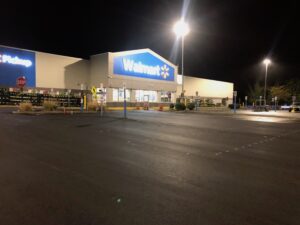 You decided to install an asphalt pavement for several valid business reasons. Asphalt pavement is more cost-effective compared to concrete pavement of similar size. Snow melts faster on asphalt than concrete, and asphalt pavements offer superior traction. The luxurious, deep color of asphalt is considered aesthetically pleasing and provides the perfect background for obvious pavement markings. Furthermore, repair and maintenance procedures are typically economical and fast. Over the years, however, you may become concerned that your aging asphalt pavement no longer conveys the image you want to project for your business. You may be tempted to have your existing pavement demolished and rebuilt. Before choosing that option, consult a reputable contractor to determine whether your pavement is suitable for asphalt resurfacing.
You decided to install an asphalt pavement for several valid business reasons. Asphalt pavement is more cost-effective compared to concrete pavement of similar size. Snow melts faster on asphalt than concrete, and asphalt pavements offer superior traction. The luxurious, deep color of asphalt is considered aesthetically pleasing and provides the perfect background for obvious pavement markings. Furthermore, repair and maintenance procedures are typically economical and fast. Over the years, however, you may become concerned that your aging asphalt pavement no longer conveys the image you want to project for your business. You may be tempted to have your existing pavement demolished and rebuilt. Before choosing that option, consult a reputable contractor to determine whether your pavement is suitable for asphalt resurfacing.
What Is Asphalt Resurfacing?
Resurfacing is a technique that a Long Island commercial paving company can use to renovate an asphalt pavement. When resurfacing asphalt paving, Suffolk County contractors virtually always start by grinding away the top two or three inches of the asphalt paving with an asphalt milling machine. New asphalt paving is then installed to replace what the contractor removed.
Are Asphalt Overlays a Type of Resurfacing?
Typically, any asphalt paving company Islip businesses might contact will use the terms interchangeably in most situations. However, asphalt overlays can sometimes be installed on top of concrete pavements that have not removed any existing material.
What Is Edge Milling When Performing Asphalt Resurfacing?
If you look at your asphalt pavement, you will likely find that it connects to other pavements, has catch basins, incorporates curbing and gutters, or has other supplemental features. It is important to keep these features at their proper elevations to prevent rough transitions, eliminate potential tripping hazards, or retain the capacity of the gutters that carry water away from the pavement. By performing edge milling around the edges of metal or concrete supplemental features, contractors can ensure that the resurfaced pavement will offer the same ride and appearance as a newly constructed pavement.
What Are the Advantages of Resurfacing Instead of Rebuilding?
Asphalt overlays are virtually indistinguishable from new pavements in terms of appearance and performance. Still, an overlay will cost only a fraction of what you would spend to remove and replace your pavement. The resurfacing procedure will also be faster, so your pavement will receive traffic sooner. Furthermore, if you maintain your overlay properly, you can repeat the process as often as needed, so you could delay the need for a full reconstruction for several decades. Stretches of the interstate highway system have gone more than 50 years with periodic resurfacing.
How Should an Asphalt Overlay Be Maintained?
Overlays should receive the same care as new asphalt pavement.
1. As soon as the asphalt has finished curing, apply sealcoating, then have fresh sealcoating about every two years.
2. If cracks develop, have them repaired as quickly as possible.
3. Refrain from overloading your pavement by allowing heavier vehicles than the pavement was engineered to support.
4. Remove oil spills, dead leaves, fuel spills, and trash regularly.
For more information about asphalt resurfacing, contact Royal Pavement Solutions. We are a well-respected Long Island commercial paving company offering a wide array of services, including asphalt paving, asphalt repairs, sealcoating, asphalt overlays, site work, asphalt cracksealing, lot striping, asphalt milling, sweeping and portering, concrete work, and building maintenance. We have a reputation for delivering superb work honestly and professionally. If you are interested in requesting a free quote, email [email protected], submit the online form, or call 844-777-7924.

